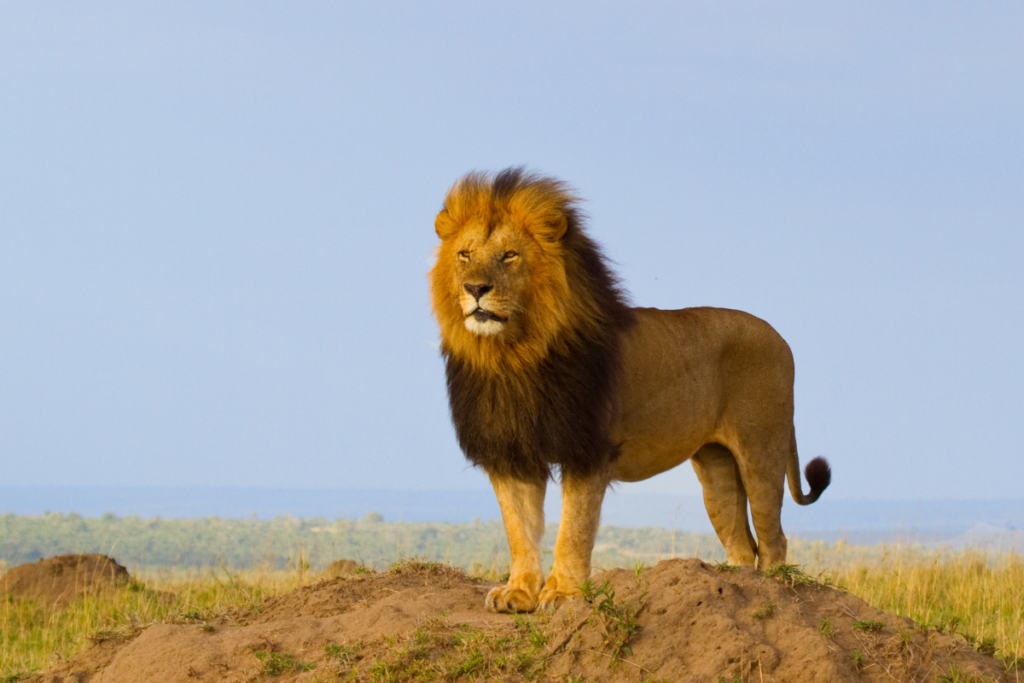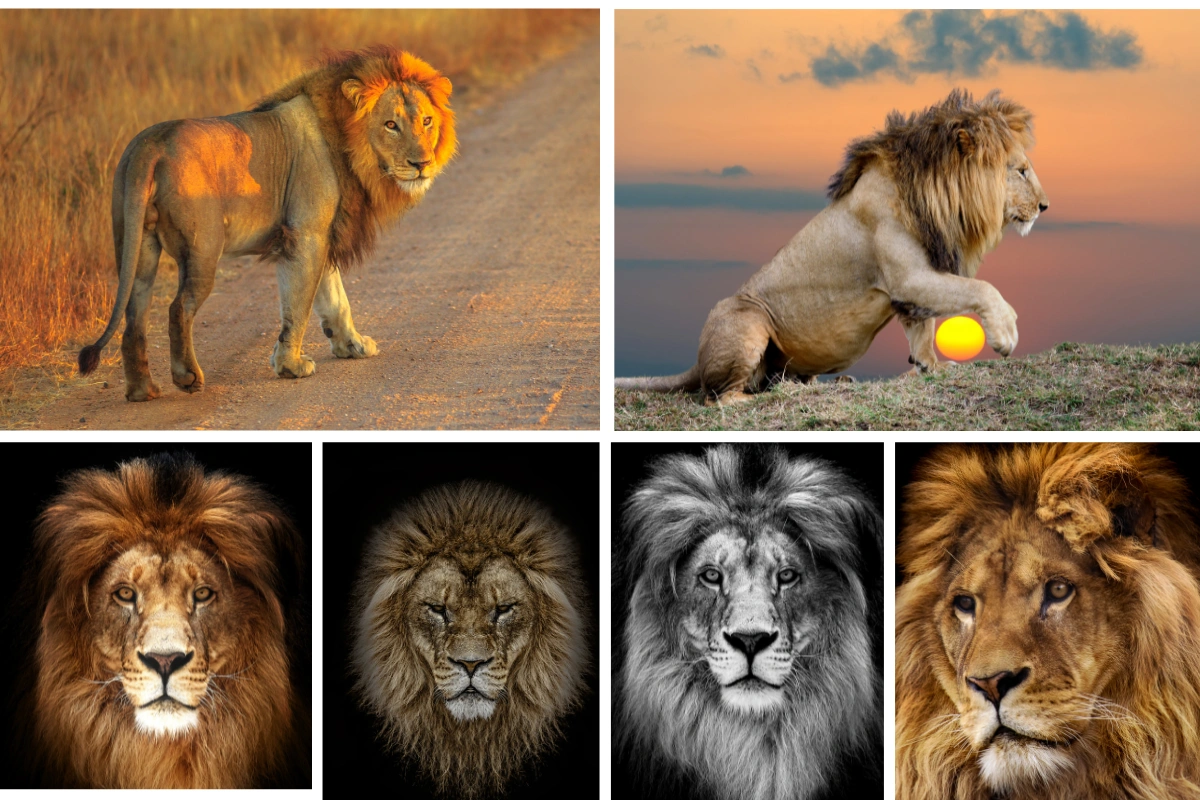10 Rare and Gorgeous Lions: Kings of the Animal Kingdom
Lions embody power, grace, and majesty in the animal kingdom. As apex predators, they have dominated ecosystems for millennia. However, not all lions are the same. Each subspecies or type has unique traits, behaviours, and habitats, making them fascinating creatures to learn about.
In this comprehensive guide, we’ll explore 10 unique types of lions—from the iconic African lion to the rare Ethiopian lion—and dive into their habitats, diets, behaviours, and conservation efforts. Let’s discover why these incredible animals deserve to be celebrated and protected.

Why Are Lions So Important?
🦁 Keystone Species: Lions maintain balance in ecosystems by regulating herbivore populations.
🌍 Cultural Icons: Lions are symbols of strength and courage in cultures worldwide.
⚠️ Conservation Priority: Many lion subspecies are endangered due to habitat loss and human-wildlife conflict.
1. African Lion 🌍
The Apex Predator of the Savanna

The African lion, often called the “King of Beasts,” is among the animal kingdom’s most iconic symbols of strength and majesty. Known for their striking golden coats and the mamale’sagnificent mane, African lions are built for dominance.
Their roaring can be heard up to 5 miles away, proclaiming their authority over the savanna. Living in pride of up to 15 members, they demonstrate unique social bonds. Females are the primary hunters, working in teams to bring down prey like zebras, wildebeests, and buffaloes. Males guard the pride, protecting it from rival males and predators.
Fast Facts
Habitat: Savannas, grasslands, and open woodlands.
Diet: Large herbivores like zebras, buffaloes, and wildebeests.
Behaviour: Known for cooperative hunting and strong social bonds.
Conservation Status: Vulnerable, with populations declining due to habitat loss.
Did You Know? African lilions’oars can be heard up to 5 miles away, serving as a territorial warning.
Unfortunately, due to habitat loss, poaching, and human-wildlife conflict, African lions are now vulnerable—conservation efforts including protected reserves and anti-poaching initiatives.
2. Asiatic Lion 🌳
The Guardians of India Forest

The Asiatic lion, native to India, is a subspecies that embodies survival against all odds. Smaller than their African relatives, Asiatic lions have shorter, sparser manes, making them visually distinct.
These lions are found exclusively in the Gir Forest of Gujarat, inhabiting its dry scrublands and thorn forests. Asiatic lions are less social than their African counterparts, forming smaller pride or living solitary lives. They prey on deer, antelope, and wild boars, relying on agility rather than brute strength. Historically,
Fast Facts
Habitat: Dry scrublands and deciduous forests.
Diet: Deer, antelope, and wild boar.
Behaviour: Smallerpride or solitary living, with males letting females eat first.
Conservation Status: Endangered, with fewer than 700 individuals left.
Did You Know? Asiatic lions were nearly extinct in the 1900s, but conservation efforts have revived their numbers.
Asiatic lions roamed the Middle East and Asia, but hunting and habitat destruction reduced their range to just one forest. Their population has grown to around 700 individuals thanks to conservation efforts, but disease outbreaks and habitat fragmentation remain significant concerns. Protecting the Asiatic lion is critical to preserving a unique piece of our natural heritage.
3. Barbary Lion (Panthera leo leo)🏔️
A Lion Lost to History

Jo Mburu/quora
The last recorded Barbary lion was shot in Morocco in 1942. The only Barbary lions left in the world are now found in zoos and are part of a global and collaborative breeding programme to ensure their future survival. (belfastcity.gov.uk)
The Barbary lion, once roaming the forests and mountains of North Africa, is remembered as one of the largest lion subspecies ever recorded. With its thick, dark mane that extended to its underbelly, the Barbary lion cut an imposing figure. These lions thrived in rugged terrains like the Atlas Mountains, adapting to cold climates and challenging environments
K.nown for their incredible strength, they preyed on Barbary sheep, wild boars, and other large mammals. Sadly, their extinction in the wild was caused by overhunting, habitat loss, and human expansion. The last known wild Barbary lion was killed in the 1920s. Today, efforts to preserve their lineage include genetic studies and captive breeding programs.
Fast Facts
Habitat: Historically, in the Atlas Mountains and North African forests.
Diet: Barbary sheep, wild boar, and other large prey.
Behaviour: More solitary than savanna lions, likely due to scarce prey.
Conservation Status: Extinct in the wild; efforts are underway to preserve their genetics.
Did You Know? Barbary lions were used in Roman gladiatorial games, symbolizing power and dominance.
The Barbary lion serves as a stark reminder of human activity’s devastating impact on wildlife and the importance of conserving what remains of our natural world.
4. West African Lion 🌾
Survivors of the Savanna

The West African lion is one of the most elusive and critically endangered lion subspecies, native to the savannas and open woodlands of West Africa. These lions are smaller and more slender than other subspecies, adapting to the dense, fragmented habitats of the region.
Their social structures are less cohesive, with pride often being more minor due to the scarcity of prey and habitat. They rely on hunting antelope, warthogs, and occasionally livestock, leading to conflicts with local communities. With fewer than 250 mature individuals remaining in the wild, their population declines rapidly.
Fast Facts
Habitat: Grasslands, savannas, and fragmented woodlands.
Diet: Antelopes, warthogs, and occasionally livestock.
Behaviour: Smallerpride or solitary hunting.
Conservation Status: Critically endangered due to poaching and habitat loss.
Did You Know? West African lions are genetically distinct from others and crucial for biodiversity.
Conservation efforts focus on protecting their remaining habitats and creating awareness about their plight. The survival of the West African lion is a test of humanity to protect and coexist with endangered species in increasingly fragmented ecosystems.
5. White Lion ❄️
NaNature’sarest Beauty

The White Lion is a genetic marvel resulting from a rare mutation known as leucism, which gives these lions their striking white coats. Contrary to popular belief, they do not have albinism; their blue or gold eyes distinguish them from true albinism.
Native to the Timbavati region of South Africa, white lions were once thought to exist only in captivity. Recent efforts have successfully reintroduced them to the wild, proving their survival capabilities despite their conspicuous appearance. White lions share the same diet and behaviours as tawny lions, preying on herbivores like zebras and impalas.
Fast Facts
Habitat: South African savannas.
Diet: Similar to other lions—wildebeests, zebras, and antelope.
Behaviour Lives in pride, exhibiting normal lion behaviour
Conservation Status: It is not a separate subspecies but is highly protected.
Did You Know? White lions are often considered sacred animals in African mythology, symbolizing prosperity and purity.
They hold cultural significance in African folklore, symbolizing purity and prosperity. While not recognized as a separate subspecies, their rarity makes them a focus of conservation programs. Preserving white lions ensures the continuation of one of nanture’s most extraordinary genetic variations.
6. Jungle Lion 🌴
The Elusive Forest Hunter

The Jungle lion is an elusive adaptation of the lion species, found in dense forests rather than open grasslands. Unlike their savanna cousins, jungle lions navigate thick vegetation, requiring greater stealth and agility.
Their prey primarily includes smaller animals such as monkeys, deer, and wild pigs. Due to the challenging forest environment, they are often solitary hunters or operate in tiny groups. Jungle lions are known for their acute senses, allowing them to adapt to the limited visibility and complex terrains of forests. Found in regions like the West
Fast Facts
Habitat: Dense forests and brushlands.
Diet: Monkeys, deer, and wild pigs.
Behaviour: More solitary, using ambush tactics for hunting.
Conservation Status: Rare, with threats from deforestation.
Did You Know? Jungle lions are proof of the lion’s incredible adaptability to diverse habitats.
In Africa and India, jungle lions face significant threats from deforestation and human encroachment. These lions highlight the species’ adaptability and underscore the urgent need to protect forest habitats, which are home to jungle lions and countless other species.
7. Cape Lion 🦁
A Lion Lost to Time

The Cape lion, native to South Africa ‘sape Province, was known for its immense size and thick black-edged mane. These lions roamed the grasslands and savannas, preying on zebras, springboks, and other herbivores.
The Cape lion was so distinct that it became the subject of numerous myths and legends. Unfortunately, overhunting and habitat loss led to their extinction in the wild by the mid-19th century. Though some claim that genetic remnants of the Cape lion exist in captivity, there is no definitive evidence.
Fast Facts
Habitat: Grasslands and savannas of South AfAfrica’sape Province.
Diet: Springbok, zebra, and large herbivores.
Behaviour: Likely lived in small pride due to prey Availability.
Conservation Status: Extinct.
Did You Know? Cape lions inspired many early European legends about Africa’s “g””ant beasts.”
“he story of the Cape lion is a tragic reminder of how unchecked human activity can lead to the disappearance of entire species. Preserving the genetic diversity of existing lions is crucial to prevent history from repeating itself.
8. Ethiopian Lion 🇪🇹
The Black-Maned Beauty of the Highlands

The Ethiopian lion, also called the “B” ack Lion,” is a unique lion population characterized by its darker, fuller mane. Found in the Ethiopian highlands, these lions are smaller than other African lions, likely due to their limited prey Availability and mountainous habitat.
They prey on antelopes and smaller herbivores, relying on agility and ambush tactics in their rugged environment. Ethiopian lions exhibit social behaviours similar to those of their savanna counterparts, living in small pride or alone. These lions hold cultural significance in Ethiopia, appearing on emblems and symbols throughout the cocountry’sistory. Unfortunately, habitat loss and conflict with humans have significantly reduced their numbers.
Fast Facts
Habitat: Ethiopian highlands and surrounding areas.
Diet: Antelope, deer, and smaller herbivores.
Behaviour: Lives in more minor pride or solitary, adapted to rugged terrain.
Conservation Status: Endangered due to habitat fragmentation and human conflict.
Did You Know? Ethiopian lions are a national symbol, appearing on the cocountry’soat of arms and emblems.
Conservation efforts are underway to protect these rare lions and their unique highland ecosystems.
9. Tsavo Lion 🌋
The Mane-Less Hunters of Tsavo

The Tsavo lion, native to KeKenya’ssavo region, is renowned for its lack of manes, a rare trait attributed to their hot, arid habitat. These lions are larger and more aggressive than other African lions, a behaviour likely influenced by food scarcity and and competition for resources.
Tsavo lions gained infamy in the late 19th century when two males terrorized railway workers, killing dozens in what became known as the “Man-Eaters of Tsavo” incident. Today, these lions prey on zebras, buffaloes, and sometimes livestock, often leading to conflict with local communities.
FastFast Facts
Habitat: Dry grasslands and shrublands of Tsavo National Park.
Diet: Zebras, buffaloes, and sometimes livestock.
Behaviour: Often solitary or in small groups; highly aggressive hunters.
Conservation Status: Vulnerable.
Did You Know? The infamous “Man-Eaters of Tsavo” killed over 30 people in 1898, and their preserved bodies are displayed in a Chicago museum..”
“espite their aggressive reputation, Tsavo lions play a vital role in their ecosystem by regulating prey populations. Conservation efforts focus on reducing human-lion conflicts and preserving the unique landscape of Tsavo National Park. https://tsavotrust.org/the-predators-of-tsavo-conservation-area/
10. Mountain Lion (Puma) 🏔️
The Stealthy Stalker of the Americas

The Mountain lion, a cougar or puma, is a solitary predator across North and South America.
While not technically a lion, this large cat shares many behavioural similarities, such as its stealthy hunting tactics and territorial nature. Mountain lions are highly adaptable, thriving in diverse habitats ranging from dense forests to arid deserts.
They prey on deer, elk, and smaller mammals, using ambush techniques to catch their prey. Unlike lions, mountain lions are solitary animals, with males and females only meeting to mate.
Fast Facts
Habitat: Forests, deserts, and grasslands across North and South America.
Diet: Deer, elk, and smaller mammals.
Behaviour: Solitary hunters with large territories.
Conservation Status: Least Concern but declining in some regions.
Did You Know? Mountain lions can leap over 15 feet in a single bound!
Despite being listed as “Least Concern,” habitat fragmentation and human expansion threaten their populations in certain regions. Mountain lions are a testament to resilience, showcasing incredible adaptability across various environments.
Conclusion
Lions are not just kings of the wild but symbols of strength, resilience, and biodiversity. However, many of these majestic animals face dire threats, from habitat loss to poaching. Understanding their unique traits and roles in ecosystems can inspire us to take action to protect them.
Which lion fascinated you the most? Let us know in the comments below!

